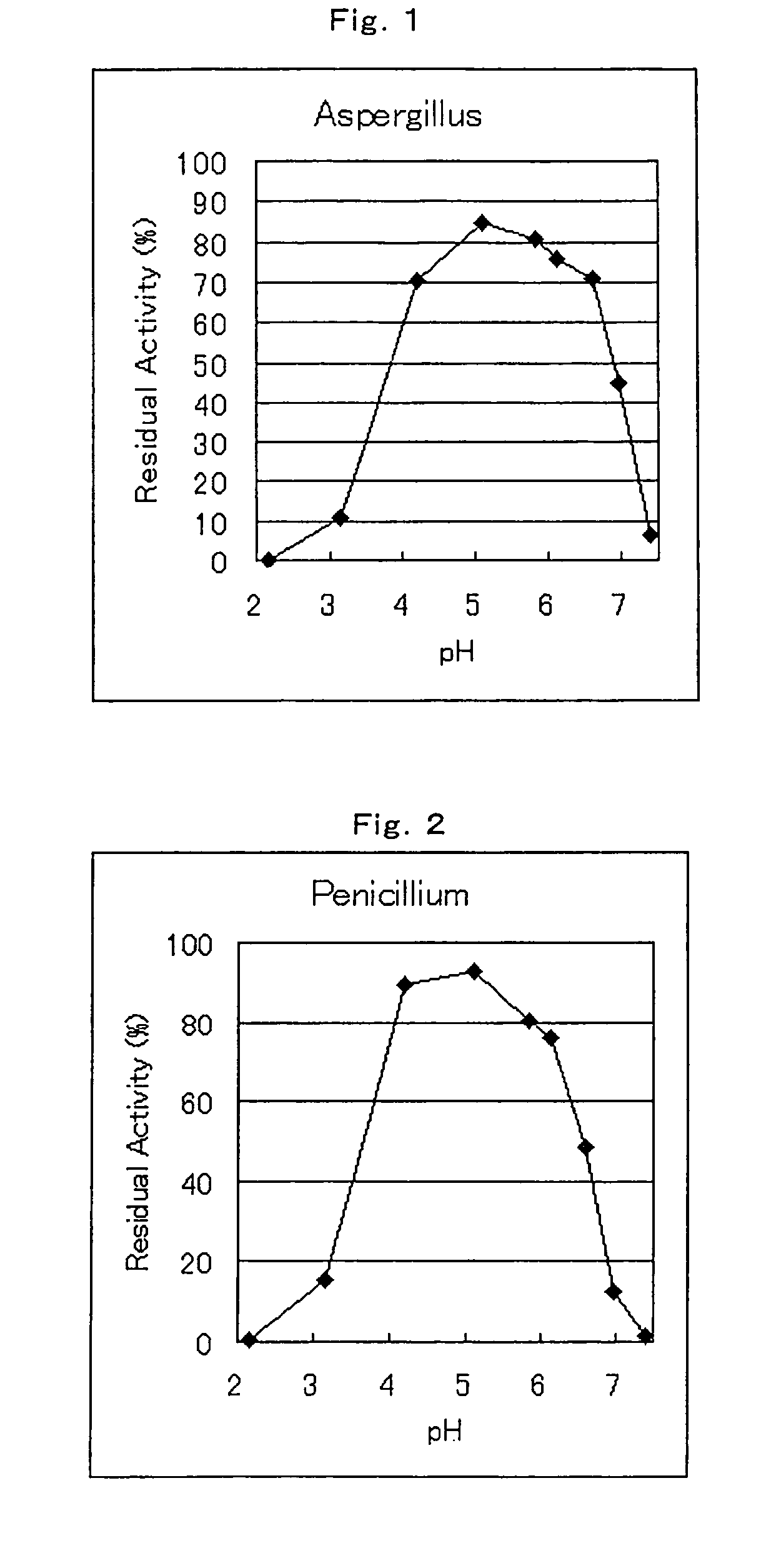Method for improving heat stability of composition containing water-soluble coenzyme-bound glucose dehydrogenase (GDH)
a technology of coenzyme-bound glucose and heat stability, which is applied in the field of improving the heat stability of compositions containing water-soluble coenzyme-bound glucose dehydrogenase (gdh), can solve the problems of poor heat stability of variants of wild-type pqqgdh
- Summary
- Abstract
- Description
- Claims
- Application Information
AI Technical Summary
Benefits of technology
Problems solved by technology
Method used
Image
Examples
example 1
Construction of Plasmid Expressing PQQ-dependent Glucose Dehydrogenase Gene
[0103]The wild-type PQQ-dependent glucose dehydrogenase gene-expression plasmid pNPG5 comprises a structural gene coding for PQQ-dependent glucose dehydrogenase derived from Acinetobacter baumanni strain NCIMB11517 inserted into the multicloning site of the pBluescript SK(-) vector. Its nucleotide sequence is represented by SEQ ID NO 2 in the sequence tables, while the amino acid sequence of PQQ-dependent glucose dehydrogenase as predicted from that nucleotide sequence is represented by SEQ ID NO 1 in the sequence tables.
[0104]5 μg of pNPG5 DNA was cleaved with the restriction enzymes BamHI and XhoI (Toyo Boseki) to isolate the structural gene part of mutant PQQ-dependent glucose dehydrogenase. The isolated DNA was reacted for 16 hours at 16° C. with pTM33 (1 μg) cleaved with BamHI and XhoI and one unit of T4 DNA ligase to ligate the DNA. The ligated DNA was used to transform competent cells of E. coli DH5α. ...
example 2
Preparation of Pseudomonas Bacterial Transformant
[0105]Pseudomonas putida TE3493 (Fermentation Research Institute Deposit No. 12298) was cultured for 16 hours at 30° C. in LBG medium (LB medium+0.3% glycerol), the cell bodies were collected by centrifugation (12,000 rpm, 10 minutes), and 8 ml of ice-cooled 5 mM K-phosphate buffer (pH 7.0) comprising 300 mM sucrose was added and the cells were suspended. The cells were collected by further centrifugation (12,000 rpm, 10 minutes), and 0.4 ml of ice-cooled 5 mM K-phosphate buffer (pH 7.0) comprising 300 mM sucrose was added thereto and the cells were suspended.
[0106]0.5 μg of the pNPG6 expression plasmid obtained in Example 1 was added to this suspension, and the cells were transformed by electroporation. The target transformant was obtained from a colony grown on LB agar medium comprising 100 μg / ml streptomycin.
example 3
Preparation of PQQ-dependent GDH Sample
[0107]500 ml of Terrific broth was dispensed into a 2L Sakaguchi flask, autoclaved at 121° C. for 20 minutes and left to cool, after which separately sterile-filtered streptomycin was added to 100 μg / ml. 5 ml of culture liquid of Pseudomonas putida TE3493 (pNPG6) which had been cultured in advance for 24 hours at 30° C. in PY medium comprising 100 μg / ml streptomycin was seeded in this medium, and cultured by aeration-agitation for 40 hours at 30° C. After completion of culture, PQQ-dependent glucose dehydrogenase activity was about 30 U / ml per 1 ml of culture liquid according to the activity measurement described above.
[0108]The aforementioned cell bodies were collected by centrifugation, suspended in 20 mM phosphate buffer (pH 7.0), disrupted by ultrasound treatment and centrifuged again to obtain a supernatant which was the raw enzyme liquid. The resulting raw enzyme liquid was isolated and purified by HiTrap-SP (Amersham Pharmacia) ion-excha...
PUM
| Property | Measurement | Unit |
|---|---|---|
| pH | aaaaa | aaaaa |
| pH | aaaaa | aaaaa |
| temperature | aaaaa | aaaaa |
Abstract
Description
Claims
Application Information
 Login to View More
Login to View More - R&D
- Intellectual Property
- Life Sciences
- Materials
- Tech Scout
- Unparalleled Data Quality
- Higher Quality Content
- 60% Fewer Hallucinations
Browse by: Latest US Patents, China's latest patents, Technical Efficacy Thesaurus, Application Domain, Technology Topic, Popular Technical Reports.
© 2025 PatSnap. All rights reserved.Legal|Privacy policy|Modern Slavery Act Transparency Statement|Sitemap|About US| Contact US: help@patsnap.com

